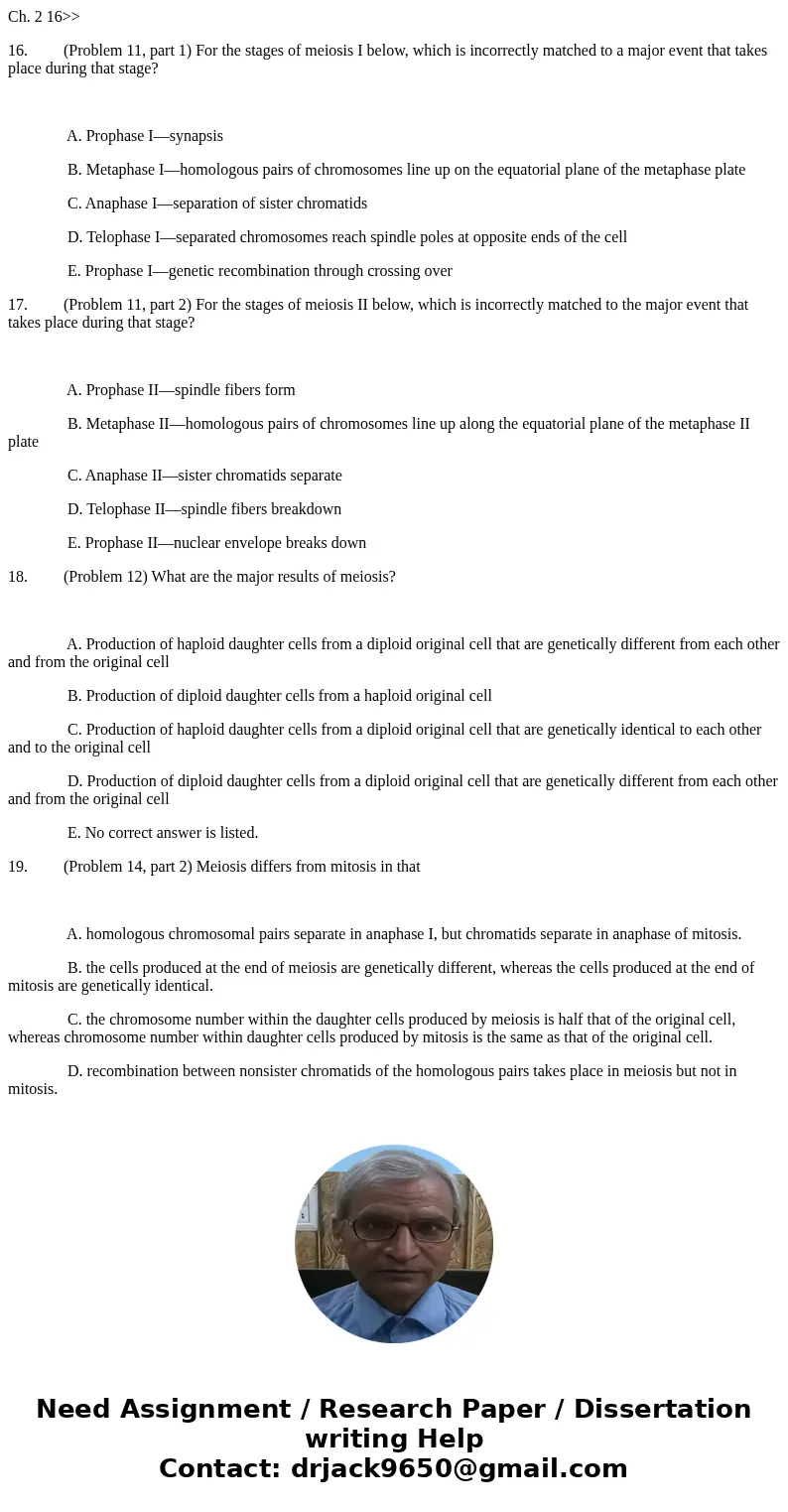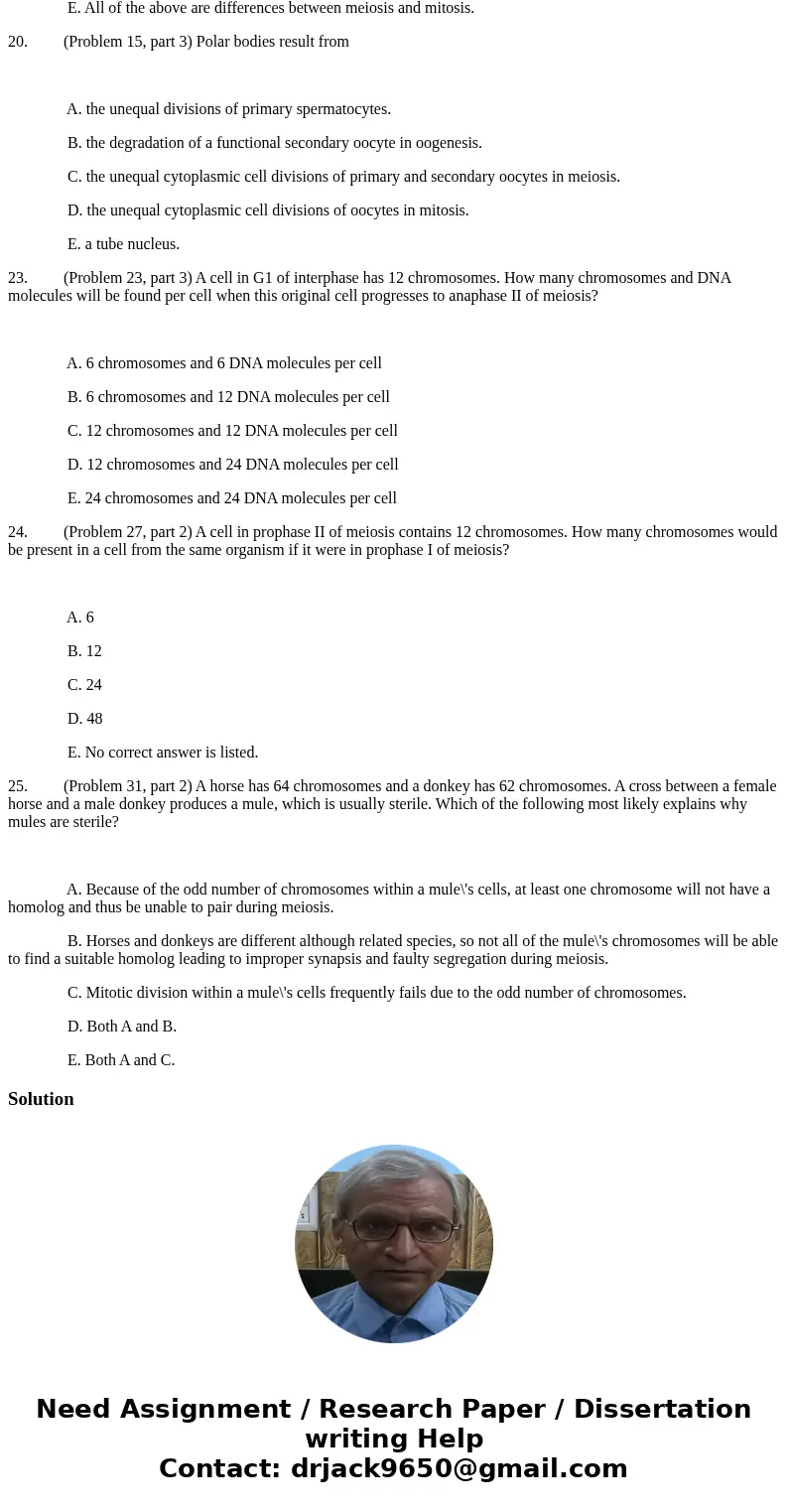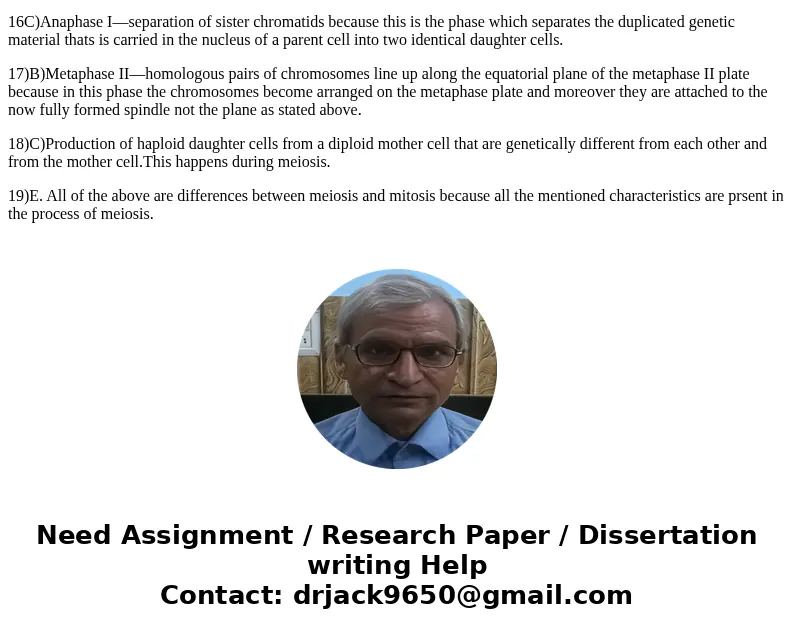Ch 2 16 16 Problem 11 part 1 For the stages of meiosis I bel
Ch. 2 16>>
16. (Problem 11, part 1) For the stages of meiosis I below, which is incorrectly matched to a major event that takes place during that stage?
A. Prophase I—synapsis
B. Metaphase I—homologous pairs of chromosomes line up on the equatorial plane of the metaphase plate
C. Anaphase I—separation of sister chromatids
D. Telophase I—separated chromosomes reach spindle poles at opposite ends of the cell
E. Prophase I—genetic recombination through crossing over
17. (Problem 11, part 2) For the stages of meiosis II below, which is incorrectly matched to the major event that takes place during that stage?
A. Prophase II—spindle fibers form
B. Metaphase II—homologous pairs of chromosomes line up along the equatorial plane of the metaphase II plate
C. Anaphase II—sister chromatids separate
D. Telophase II—spindle fibers breakdown
E. Prophase II—nuclear envelope breaks down
18. (Problem 12) What are the major results of meiosis?
A. Production of haploid daughter cells from a diploid original cell that are genetically different from each other and from the original cell
B. Production of diploid daughter cells from a haploid original cell
C. Production of haploid daughter cells from a diploid original cell that are genetically identical to each other and to the original cell
D. Production of diploid daughter cells from a diploid original cell that are genetically different from each other and from the original cell
E. No correct answer is listed.
19. (Problem 14, part 2) Meiosis differs from mitosis in that
A. homologous chromosomal pairs separate in anaphase I, but chromatids separate in anaphase of mitosis.
B. the cells produced at the end of meiosis are genetically different, whereas the cells produced at the end of mitosis are genetically identical.
C. the chromosome number within the daughter cells produced by meiosis is half that of the original cell, whereas chromosome number within daughter cells produced by mitosis is the same as that of the original cell.
D. recombination between nonsister chromatids of the homologous pairs takes place in meiosis but not in mitosis.
E. All of the above are differences between meiosis and mitosis.
20. (Problem 15, part 3) Polar bodies result from
A. the unequal divisions of primary spermatocytes.
B. the degradation of a functional secondary oocyte in oogenesis.
C. the unequal cytoplasmic cell divisions of primary and secondary oocytes in meiosis.
D. the unequal cytoplasmic cell divisions of oocytes in mitosis.
E. a tube nucleus.
23. (Problem 23, part 3) A cell in G1 of interphase has 12 chromosomes. How many chromosomes and DNA molecules will be found per cell when this original cell progresses to anaphase II of meiosis?
A. 6 chromosomes and 6 DNA molecules per cell
B. 6 chromosomes and 12 DNA molecules per cell
C. 12 chromosomes and 12 DNA molecules per cell
D. 12 chromosomes and 24 DNA molecules per cell
E. 24 chromosomes and 24 DNA molecules per cell
24. (Problem 27, part 2) A cell in prophase II of meiosis contains 12 chromosomes. How many chromosomes would be present in a cell from the same organism if it were in prophase I of meiosis?
A. 6
B. 12
C. 24
D. 48
E. No correct answer is listed.
25. (Problem 31, part 2) A horse has 64 chromosomes and a donkey has 62 chromosomes. A cross between a female horse and a male donkey produces a mule, which is usually sterile. Which of the following most likely explains why mules are sterile?
A. Because of the odd number of chromosomes within a mule\'s cells, at least one chromosome will not have a homolog and thus be unable to pair during meiosis.
B. Horses and donkeys are different although related species, so not all of the mule\'s chromosomes will be able to find a suitable homolog leading to improper synapsis and faulty segregation during meiosis.
C. Mitotic division within a mule\'s cells frequently fails due to the odd number of chromosomes.
D. Both A and B.
E. Both A and C.
Solution
16C)Anaphase I—separation of sister chromatids because this is the phase which separates the duplicated genetic material thats is carried in the nucleus of a parent cell into two identical daughter cells.
17)B)Metaphase II—homologous pairs of chromosomes line up along the equatorial plane of the metaphase II plate because in this phase the chromosomes become arranged on the metaphase plate and moreover they are attached to the now fully formed spindle not the plane as stated above.
18)C)Production of haploid daughter cells from a diploid mother cell that are genetically different from each other and from the mother cell.This happens during meiosis.
19)E. All of the above are differences between meiosis and mitosis because all the mentioned characteristics are prsent in the process of meiosis.



 Homework Sourse
Homework Sourse